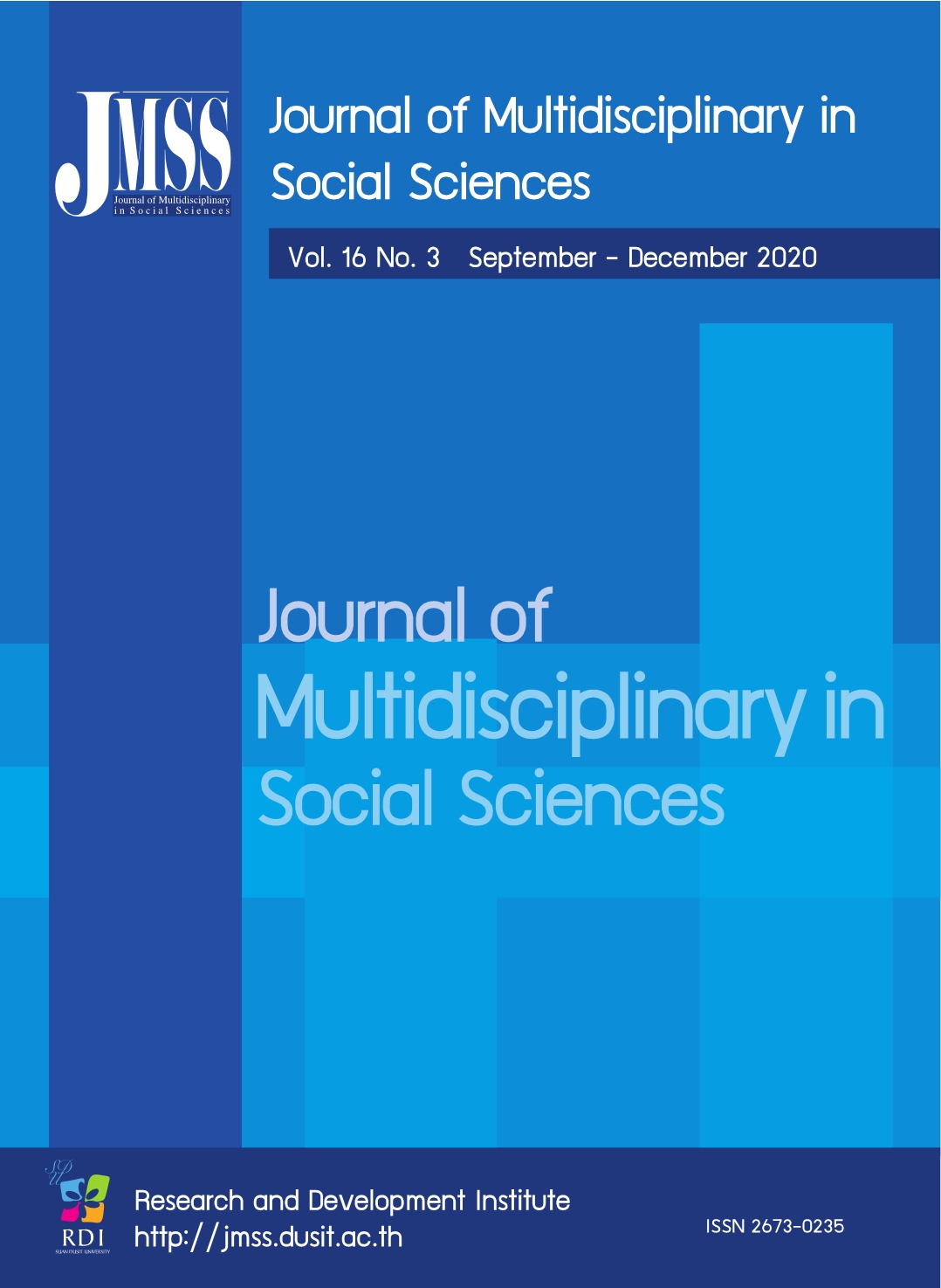The Development of Turnover Intention Prediction Model for Out-of-Office Workers in Thailand
Keywords:
Binary logistic regression, Burnout, Turnover intentionodelAbstract
The study of the development of turnover intention prediction model for out-of-office workers in Thailand aims to investigate the factors affecting probability of turnover intention and to develop the most suitable turnover intention prediction model for out-of-office workers by using binary logistic regression approach. This is a quantitative social science survey research. The population of the study are professional employees that are assigned to work outside the office, including but not limited to salespersons, financial auditors, management consultants, medical representatives, real estate agents and other professional jobs that often work outside an office. Research tools are questionnaires and rating scales. A convenience sampling method was applied. Self-administrative questionnaires both hard copy and electronic form were directly distributed to various out-of-office workers in Thailand. In this study, 420 sample size was collected and separate into 67% of training set and 33% of test set. The well-fitted turnover intention prediction from binary logistic regression approach for out-of-office worker can be deliberately developed and fitted with empirical data. It is obvious and clear that all thelegacy negative work-related factors are still relevant and contribute to the prediction of turnover intention of employees. Organizations should utilize any possible countermeasures to mitigate these risks. For future research, qualitative research should be done so as to gain more insights regarding turnover intention.
References
Akova, O., Cetin, G., & Cifci, I. (2015). The Relation between Demographic Factors and the Turnover Intention in Pre-opening Hotel Businesses. Procedia - Social and Behavioral Sciences, 207, 377-384.
Archer, K. J., & Lemeshow, S. (2006). Goodness-of-fit test for a logistic regression model fitted using survey sample data. Stata Journal, 6(1), 97-105.
Bakker, A. B., & Demerouti, E. (2014). Job demands-resources theory. Wellbeing: A complete reference guide, 1-28.
Bannister, B. D., & Griffeth, R. W. (1986). Applying a Causal Analytic Framework to the Mobley, Horner, and Hollingsworth (1978) Turnover Model: A Useful Reexamination. Journal of Management, 12(3), 433- 443.
Baruch, Y. (2000). Teleworking: benefits and pitfalls as perceived by professionals and managers. New Technology, Work and Employment, 15(1), 34-49.
Chen, X., Ran, L., Zhang, Y., Yang, J., Yao, H., Zhu, S., & Tan, X. (2019). Moderating role of job satisfaction on turnover intention and burnout among workers in primary care institutions: A cross-sectional study. BMC Public Health, 19(1), 1526.
Cochran, W. G., Mosteller, F., & Tukey, J. W. (1954). Principles of sampling. Journal of the American Statistical Association, 49(265), 13-35.
Demoussis, M., & Giannakopoulos, N. (2007). Exploring job satisfaction in private and public employment: Empirical evidence from Greece. Labour, 21(2), 333- 359.
Gajendran, R. S., & Harrison, D. A. (2007). The good, the bad, and the unknown about telecommuting: meta-analysis of psychological mediators and individual consequences. Journal of applied psychology, 92(6), 1524.
Golden, T. D., Veiga, J. F., & Dino, R. N. (2008). The impact of professional isolation on teleworker job performance and turnover intentions: Does time spent teleworking, interacting face-to-face, or having access to commu-nication-enhancing technology matter?. Journal of Applied Psychology, 93(6), 1412.
Hammer, E. R., & Van Tassell, D. (1983). On the Issue of Public vs. Private Sector Motivation: Have the Stereotypes Been Debunked?. Public Personnel Management, 12(3), 282-289.
Knight, W. E., & Leimer, C. L. (2010). Will IR staff stick? An exploration of institutional researchers’ intention to remain in or leave their jobs. Research in Higher Education, 51(2), 109-131.
Liaw, A., & Wiener, M. (2002). Classification and regression by randomForest. R news, 2(3), 18-22.
Marshall, G. W., Michaels, C. E., & Mulki, J. P. (2007). Workplace isolation: Exploring the construct and its measurement. Psychology and Marketing, 24(3), 195-223.
Maslach, C., Jackson, S. E., Leiter, M. P., Schaufeli, W. B., & Schwab, R. L. (1986). Maslach burnout inventory. (3463-3464). CA: Consulting psychologists press.
Midi, H., Sarkar, S. K., & Rana, S. (2010). Collinearity diagnostics of binary logistic regression model. Journal of Interdisciplinary Mathematics, 13(3), 253-267.
Narayanan, L., Menon, S., & Plaisent, M. (2017). Telecommuting: The Work Anywhere, Anyplace, Anytime Organization in the 21st Century. Journal of Marketing and Management, 8(2), 47-54
Nathans, L. L., Oswald, F. L., & Nimon, K. (2001). Interpreting Multiple Linear Regression: A Guidebook of Variable Importance, 17(1), 9.
Pratt, J. H. (1984). Home teleworking: A study of its pioneers. Technological Forecasting and Social Change, 25 (1), 1-14.
Ryan, R. M., & Deci, E. L. (2000). Intrinsic and Extrinsic Motivations: Classic Definitions and New Directions. Contemporary Educational Psychology, 25(1), 54-67.
Simha, A., Elloy, D. F., & Huang, H. C. (2014). The moderated relationship between job burnout and organizational cynicism. Management Decision, 52(3), 482-504.
R Core Team (2020). R: A language and environment for statistical computing. Retrieved November 7, 2020, from http://www.R-project.org
Van den Broeck, A., Vansteenkiste, M., De Witte, H., Soenens, B., & Lens, W. (2010). Capturing autonomy, competence, and relatedness at work: Construction and initial validation of the Work-related Basic Need Satisfaction scale. Journal of Occupational and Organizational Psychology, 83(4), 981-1002.
Downloads
Published
How to Cite
Issue
Section
License

This work is licensed under a Creative Commons Attribution-NonCommercial-NoDerivatives 4.0 International License.








